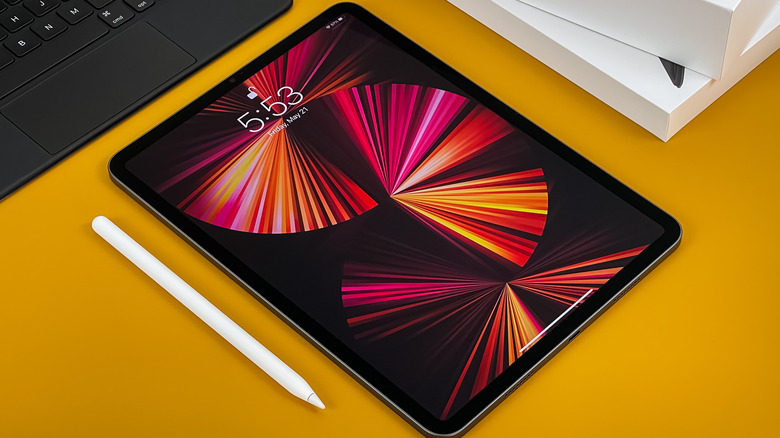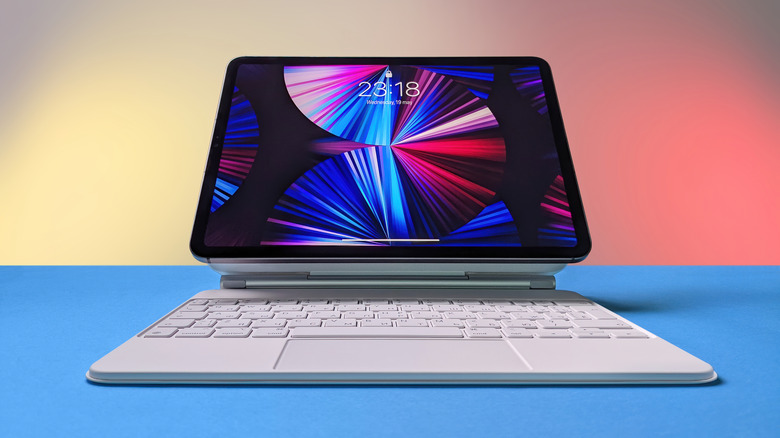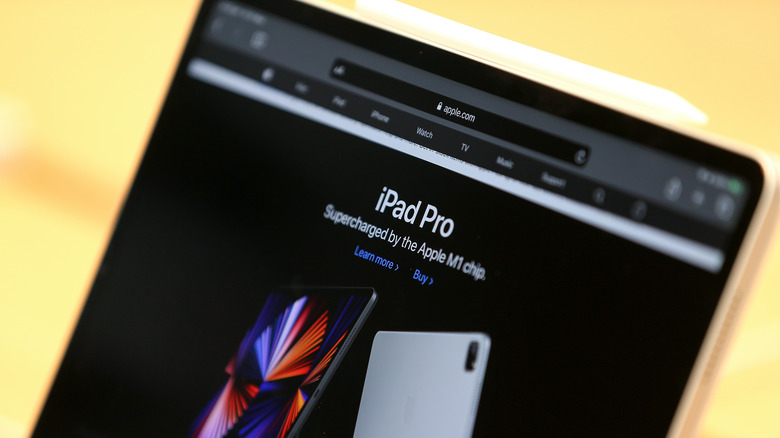Apple Could Launch A 14-Inch iPad Pro With A Mini LED Display Next Year
Apple has been taking significant steps to make the iPad a more powerful computer while still ensuring it does not entirely replace the Mac. At its annual WWDC developer conference for 2022, Apple announced new multitasking tools, including Stage Manager, that overlap in the upcoming versions of macOS and iPadOS. In terms of hardware, too, Apple has been making the iPad bigger to bring it on par with MacBooks, while a smaller 12-inch MacBook seems to be on the list of upcoming Apple devices. A recent rumor adds to this list, suggesting Apple might launch a bigger, 14-inch iPad Pro with a Mini LED display soon.
The rumor comes from Ross Young, a display analyst and Apple supply chain commentator. According to Young, Apple has already begun developing a new iPad Pro model with a 14.1-inch display. As mentioned above, this purported iPad Pro uses Mini LEDs for the display's backlight.
In 2021, Apple began using "Liquid Retina XDR" displays with Mini LEDs instead of the traditional LED-backlit LCDs as seen on older iPad and MacBook models. This is because their miniature size allows Mini LEDs to offer more precise backlighting, providing better contrast and color precision.
New iPad won't arrive until 'early 2023'
In addition to the bigger display with Mini LED technology, the alleged 14.1-inch iPad Pro will also support ProMotion technology. ProMotion is the moniker Apple uses for variable refresh rate. Traditional displays had — and many still have — a 60Hz refresh rate, which means the display refreshes 60 times every second. However, newer Apple displays — including those on the 12.9-inch iPad Pro and the new 14-inch and 16-inch MacBook Pro — feature a 120Hz variable refresh rate, meaning they refresh up to 120 times every second depending on the content being displayed.
In simple terms, a higher refresh rate means that animations on display appear much smoother and free from any visual stuttering effects. On the iPad, specifically, a higher refresh rate also reduces the lag between the tip of the Apple Pencil and the trail that follows it on display.
Young also suggests that despite these new iPad Pro models already being in development, they will not launch until early 2023. That launch timeline, too, is tentative and may change in the coming months.
Further, Young makes another claim about the displays Apple uses on the iPad Pro models. Currently, the 11-inch model comes with an LED-backlit LCD, while the 12.9-inch iPad Pro features a Mini LED display. The analyst, however, believes that the future 11-inch and 12.9-inch models will come with OLED displays while the 14.1-inch model will be equipped with a Mini LED display. The use of OLED displays could improve the visual quality of the iPad Pro even further.
Supply chain challenges for new iPad Pro displays
Considering Apple has substantial experience dealing with Mini LED display technologies, getting the 14.1-inch iPad Pro's display manufactured will not be significantly challenging for the company. As mentioned above, the 14-inch and the 16-inch MacBook Pro with M1 Pro and M1 Max chipsets also feature Mini LED displays in addition the 12.9-inch iPad Pro.
The company, however, has been grappling with a limited supply of Mini LED panels from its two partnered manufacturers — Taiwan's Epistar and Germany's Ams Osram. To ramp up supply and meet the growing demand for Mini LED displays, Epistar recently set up new manufacturing facilities in China, according to MacRumors. At the same time, Apple also onboarded a third manufacturer, Sanan Optoelectronics, as per DigiTimes. These new manufactories can be expected to boost supply for Apple, but the fact that the recently-launched 2022 MacBook Air missed out on the new display technology and continues to use the same old LCD technology may suggest that shortages are still a factor.
We will have to wait and see when the situation eases for Apple, but the transition to Mini LED and OLED on iPad Pro, nonetheless, is exciting for many.


